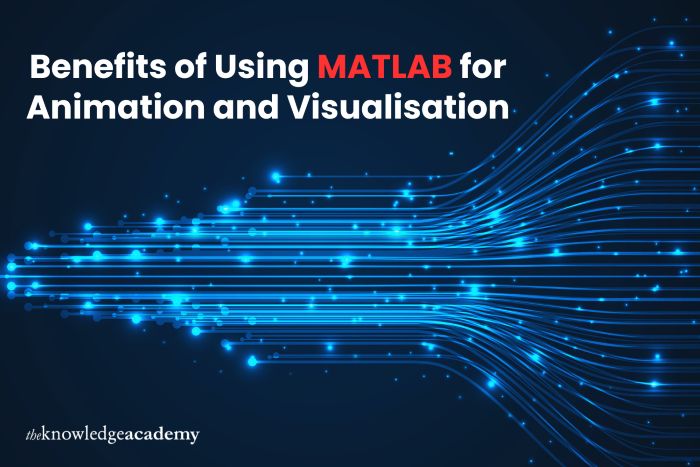Have you ever wondered how to bring visual data to life with animations? MATLAB is an excellent way to explore animation and visualisation. MATLAB Courses help you gain skills whether you are a beginner or a professional. But What is MATLAB? It is a high level programming language and environment used for numerical computing and visualisation. Let’s explore the benefits and see how MATLAB can make your animation and visualisation work easier and more effective.
Why MATLAB is Perfect for Animation and Visualisation
MATLAB offers a unique combination of simplicity and power. It helps in creating dynamic animations and clear visualisations effortlessly. Here are some reasons why it stands out:
User-Friendly Interface: MATLAB has several built in tools meant to enable animations and visualisations. MATLAB easily generates complicated 3D visualisations, plots 2D graphs, and animates dynamic systems. The platform has comprehensive documentation and examples to assist users in starting swiftly and effectively.
Extensive Functionality: MATLAB has a multitude of built in routines aimed at facilitating animations and visualisations. MATLAB provides capabilities for plotting 2D graphs, generating complex 3D graphics, and animating dynamic systems with ease. It furthermore accommodates many file types for seamless data input and export.
Customisation Options: MATLAB offers comprehensive freedom to tailor your visual material. You may refine colours, tweak typefaces, modify axis scales, and include comments to adhere to certain presentation or publishing requirements. Moreover, sophisticated scripting features provide customised animations that fulfil specific project needs.
Efficient Data Management: Managing extensive datasets might be arduous; nevertheless, MATLAB enhances data processing to guarantee seamless and responsive animations. Its excellent memory management and rapid processing skills enable users to process millions of data points effectively, yielding accurate and distinct visual representations.
How MATLAB Enhances Data Visualisation
Data visualisation is key to understanding complex information. MATLAB simplifies this process with its powerful features:
Interactive Plots: MATLAB allows you to create interactive charts and graphs with features like zooming, panning, and data brushing. These features enable users to examine data points comprehensively and get enhanced insights. Interactive visualisations facilitate the identification of patterns, irregularities, and linkages that static charts may overlook.
Real-Time Visualisation: Require monitoring of live data? MATLAB can provide real-time visualisations that facilitate monitoring changes as they occur. The real-time plotting functionalities of MATLAB ensure that you remain informed about changing data streams, whether related to financial market movements, sensor readings, or scientific research.
Advanced 3D Visualisations: MATLAB offers a variety of tools for depicting data via 3D surface plots and contour maps, enhancing visual attractiveness. Users may rotate, zoom, and modify 3D models to explore various viewpoints and get an enhanced understanding of complex facts. This functionality is very beneficial in domains like engineering and medical imaging.
Data Trends and Patterns: Visualising temporal trends is straightforward using MATLAB. It provides sound insights by effectively illustrating data patterns. Utilising built-in capabilities such as plot, bar, and scatter, users generate complex visual representations of data to identify seasonal patterns, connections, and anomalies quickly.
Boosting Productivity with MATLAB Animations
Animation is a powerful way to present data. MATLAB facilitates simplicity and efficiency. Here’s how it helps:
Automated Animation Generation: Utilising MATLAB scripts, one may automate the animation process by establishing loops and functions that produce dynamic graphics over time. This automation reduces human labour and facilitates uniformity and precision in presentations.
Step-by-Step Motion Control: You can control animations frame by frame, ensuring precision in your visual storytelling. The frame-by-frame methodology of MATLAB enables users to modify parameters at each stage, enhancing control over complex animations.
Seamless Integration with Other Tools: MATLAB works well with software like Excel and Python. This facilitates seamless data import and export, enabling users to integrate the visualisation capabilities of MATLAB with data analysis tools from other platforms for a holistic workflow.
Clear Communication of Concepts: Animated visuals created in MATLAB make complex ideas easier for technical and non-technical audiences to understand. MATLAB animations facilitate the elucidation of scientific concepts and the clarification of business trends, enhancing engagement and simplifying information.
Enhanced Presentation Capabilities: MATLAB animations can be exported into various formats, such as GIFs, videos, and interactive HTML files. This guarantees interoperability across several platforms, facilitating the dissemination of knowledge to a broader audience.
Conclusion
Exploring the right learning path is essential if you’re ready to enhance your skills. Whether you are a beginner or an experienced professional, having structured guidance can make all the difference. Consider The Knowledge Academy courses to improve your understanding of MATLAB and take your animation and visualisation skills to the next level.





